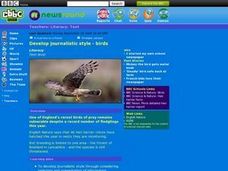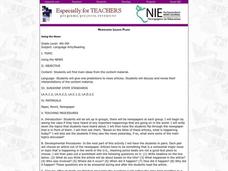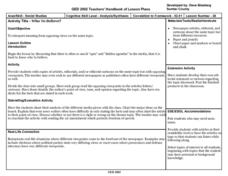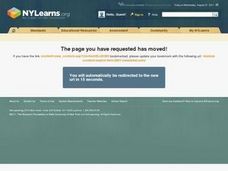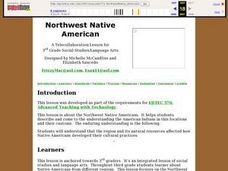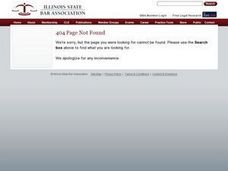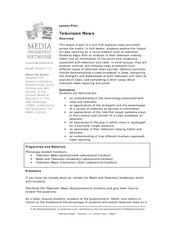Curated OER
Science TV: Making it Real
Students explore the ways science is presented in a children's television show. Students conduct internet research, and then create and design a skit that highlights the problem-solving process.
Curated OER
Editorial Cartoon: Equal Opportunity
students explore how editorial cartoons often use familiar adages or idioms in new ways to make a point about something.
Curated OER
Reporting News About Rosa Parks
Students investigate racism by completing a writing assignment. In this civil rights lesson, students research facts about Rosa Parks in order to write a newspaper article about her. Students utilize the Internet for research...
Curated OER
What's in the News?
In this analysing articles worksheet, students read two newspaper articles about the issue of radon and answer six questions that allow students to reflect on how the articles were written and what is left unknown to the readers.
Curated OER
Creating a Newscast on the Cold War
Students research the events of a specific year of the Cold War. In this Cold War lesson, students investigate the causes of the Cold War and highlight the events of a particular year. Students create a...
Curated OER
Japanese Culture--Comparing the Japanese Educational System to the American
Students study the Japanese educational system and compare and contrast it to the American system. They discuss a typical school day in America and what they believe a typical day is for a Japanese student. Next they write an editorial...
Curated OER
Why Predict?
Twelfth graders examine the process of predicting. They observe a fine art transparency, discuss their predictions about the artwork, identify the types of predictions made during a weather broadcast, and evaluate headlines from...
Curated OER
Develop Journalistic Style--Birds
Students develop journalistic style of writing through considering selection and presentation of information. Students tie science with journalistic writing. Students summarize several science species.
Curated OER
Love in a Time of Tv Hysteria
Students read a longer text and participate in a number of comprehension activities.
Curated OER
Using the News
Learners give oral predictions to news articles. They discuss and revise their interpretations of the content material.
Curated OER
News Anchor
Students view selected clips from news programs, analyzing the volume, stress and pacing of the deliverance. They prepare and deliver a one-minute presentation based on a current news story.
Curated OER
Confederation Editorials
Students investigate what an editorial is and will write one, for their simulated newspaper, about Confederation using primary-source documents from the "EvidenceWeb" portion of the Learning Centre, on the Library and Archives Canada...
Curated OER
Who To Believe?
Students interpret meaning from opposing views on the same topic, and discuss that there is often so much "spin" and "hidden agendas" in the media.
Curated OER
Spedwards Times
Students research parts of existing newspapers by having a newspaper treasure hunt. Students glue pieces found on poster board with headings. Students meet and interview a newspaper reporter. Students create a name and masthead for...
Curated OER
W. Eugene Smith: Photojournalism and Compassion
Young scholars examine the work of the photojournalist W. Eugene Smith. They analyze photo-essays by Smith, construct a pinhole camera, and create their own photo-essay.
Curated OER
Read More Than Words
Students, in groups, visually read photographs from the Farm Security Administration taken during the Great Depression. They analyze the photos and present their observations to the class.
Curated OER
Interdisciplinary Unit On Wellness
Students create a portfolio throughout their middle school years on wellness. Students explore their awareness of the connections between health, physical education, and family and consumer sciences with particular emphasis on the areas...
Curated OER
Press Review
How can word choice affect a political speech? Middle and high schoolers examine the text of the 1999 State of the Union Address, and then determine how newspaper articles and television reports describe and analyze the event. Use this...
Curated OER
Blow the Best Bubbles
Here is an exciting, and meaningful science lesson on the formation of bubbles! Young scientists have three cups with a variety of solutions in them. One cup has detergent only, one has glycerin added to it, and the third has corn syrup...
Curated OER
Patti Smith: Dream of Life
How do artists affect and how are artists affected by the time periods in which they live? Learners examine the life and work of controversial and influential cultural artist Patti Smith as they seek answers to this essential question....
Curated OER
Northwest Native American
Third graders describe and come to the understanding the American Indians in this locations and their customs. They explain that the region and its natural resources affected how Native Americans developed their cultural practices.
Curated OER
What is Plagiarism?
What is plagiarism? Middle schoolers create a class definition of plagiarism and examine the importance of crediting people for their ideas. They review official school policy on plagiarism and study the consequences of presenting the...
Curated OER
Television News
Different media sources portray news in a variety of ways. In groups of three, learners look at different news sources, bringing in all the findings the next day. Three handouts help scholars compare sources, define specific terms used...
PBS
U.S. Agricultural Subsidies and Nutrition
Most young people don't spend a lot of time thinking about why some foods cost less than others. This resource uses clips from the documentary, Food, Inc. to explore the impact of agricultural subsidies on nutrition, health, and the...









